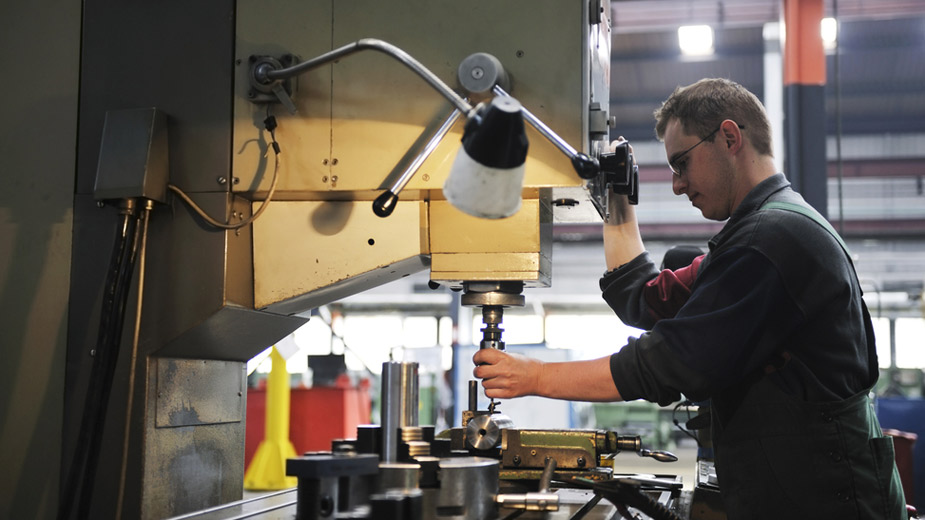After Hits from Virus, Manufacturing Now Looks at How to Rebound
YOUNGSTOWN, Ohio – Despite the hard economic hits the coronavirus has delivered to northeastern Ohio’s leading industries like manufacturing, experts say diversity and advancements in technology will help lead to a faster recovery.
While unemployment is not expected to return to its pre-pandemic levels until at least 2025, the region’s gross domestic product is expected to rebound in two years, according to a report from Team NEO, a nonprofit economic development organization for 18 counties in northeast Ohio.
Manufacturing fell 9.1%, headquarters operations dropped 6.1% and health care lost 2.4% compared with 2019. All of these segments had job loss, including 6% in manufacturing, according to Jacob Duritsky, VP of strategy and research for Team NEO.
The report, “Northeast Ohio Economic Projections Post COVID-19,” was released Monday. It notes that sectors that rely on strong structural demand from consumer perspective were hard hit, such as aerospace, which saw a 20% to 25% decline, and transportation equipment, which was down 20%.
“Our economy relies on manufacturing. Slowdowns in manufacturing, which normally occur at the same time as the entire economy, hurt everyone. If this recession gets deeper, we must all be prepared to weather a storm,” said Ethan Karp, president and CEO of MAGNET. “Fortunately, we always come back, and if our manufacturers can continue to find ways to explore new technologies even when things are tough, they can emerge stronger from this slowdown.”
Team NEO’s study is based on Moody’s Analytics, which anticipates a second round of federal stimulus payments and that the economy will not face another shutdown due to a second wave of COVID-19, the disease spread by the coronavirus.
Duritsky said that in past recessions, GDP, a comprehensive scorecard to measure economic health, has always led the way. Despite unemployment numbers lagging, he believes manufacturing will remain a strong economic driver because of how it has diversified.
“Over the past 20 years, we’ve become a much more productive economy, particularly as it relates to manufacturing. We’re doing more, we’re just doing it with slightly less people,” he said.
Jessica Borza, executive director for the Mahoning Valley Manufacturers Coalition said the recovery will not be a one-size-fits-all plan.
“Even within the MVMC membership, each company is unique and may be affected very differently. We see that now among our member companies, and I’m afraid none of us has a crystal ball to see where the manufacturing environment is headed. We believe it’s going to be a very dynamic situation,” Borza said.
While Duritsky said job loss in manufacturing may have shifted talent alignment and shortened a skills gap problem, Karp and Borza see it differently.
“We went from a few months ago having a significant talent shortage and historically low unemployment rates to unfortunately having a lot of excess talent on the market,” Duritsky said.
Borza said coalition members believe manufacturing will remain strong, though the skills gap and a workforce shortage will continue as demographics point to a larger group getting closer to retirement age.
“Because of this, our membership has asked MVMC to remain focused on our efforts to strengthen the pipeline of talent as we continue to support existing workers in increasing their skills,” Borza said.
Karp agrees, adding: “We know that we will again have a major skilled labor shortage, it is just a matter of time. How manufacturers prepare today will make the difference of whether they will be able to get the people they want when the economy heats up again.”
Companies can re-evaluate processes and search for opportunities coming out of the pandemic, according to William Koehler, CEO for Team NEO.
“Now is a time to be thinking of upskilling and reskilling and higher education,” he said.
Karp and Duritsky point to companies investing in technology and training to remain competitive.
Duritsky said some larger plants implemented to technology and automation, noting that 85% of northeastern Ohio’s manufacturers have less than 200 employees. Such measures are just as vital for small companies.
“Designing new ways to engage, train, and find people now, even when things seem easier because unemployment is high, is the foundation for future success,” Karp said. “Building pipelines to get great talent takes years, so even if things slow down, we need to still invest in keeping those pipelines healthy despite pulling fewer people through them.
Other industries hit extremely hard from the pandemic included travel, entertainment, hotel and accommodation industries.
“While there was job loss throughout most sectors of the economy, those sectors were hit the biggest, and 15% to 25% of those jobs may remain gone through the course of 2020,” Duritsky said.
Copyright 2024 The Business Journal, Youngstown, Ohio.



